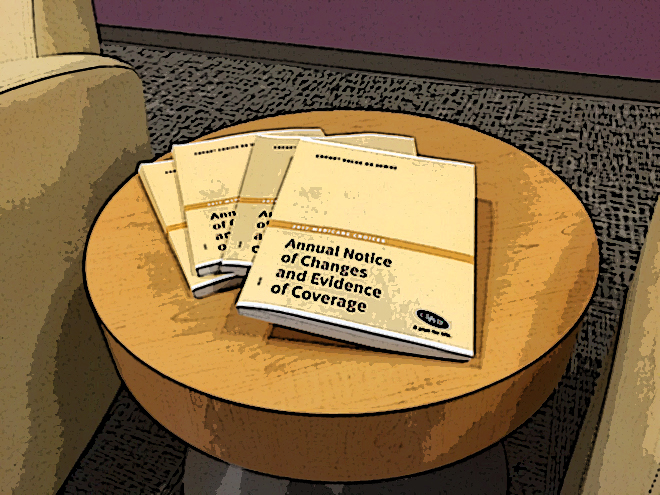Two Important Documents Medicare Members Must Read

Medicare members should pay attention to their mailbox come fall. Two important documents will arrive as the leaves begin to change – the Annual Notice of Change (ANOC) and Evidence of Coverage (EOC). These documents are crucial to your Medicare planning and can help you ensure you receive coverage that fits your needs.
Unless you’re new to Medicare, you’re likely familiar with these documents. You’re also aware that they can be lengthy and jam-packed with information. Unfortunately, some Medicare members are too intimidated to digest the material and end up settling for coverage that isn’t the best fit.
We’re here to help. We’ve rounded up some information that will help you understand your ANOC and EOC, why they’re important, and how to use them to your advantage.
What are the ANOC and EOC?
You should receive an ANOC from your health plan every September. This document will detail changes in coverage, cost, or service area that will be effective starting in January. Armed with this information, you can review any changes for the coming year and decide whether the plan is right for you.
While the ANOC focuses on changes to your plan, the EOC is a comprehensive document that outlines your benefits, cost-share, how the plans works, and what the plan covers. You should also receive this document every September. In fact, your ANOC and EOC may arrive together as one booklet.
You’ll want to review these documents to prepare for Medicare open enrollment, called AEP or the Annual Election Period, which spans from October 15 to December 7. This is your one chance to make changes to your Medicare Advantage or prescription drug plan.
The arrival of these two important documents is timed with the build-up to open enrollment, so you can do a thorough review before making any decisions. Even if your plan has few changes in the coming year, reviewing your ANOC and EOC will allow you to compare your plan to other options.
What to look for in the documents
Your ANOC is the shorter of the two documents and will be easier to digest. Since it’s dedicated exclusively to changes in your plan, you’ll want to dig in and review everything to see how you may be impacted by upcoming changes.
Your EOC, on the other hand, will be longer than some novels you’ve read. It does not, however, need to be consumed chronologically to make sense.
Let the table of contents be your guide. Your EOC is conveniently broken up into topical sections such as “What you pay for your Part D prescription drugs” and “Important phone numbers and resources.”
Contact numbers are useful and necessary, of course, but information such as what you’ll pay for prescription drugs is a key component of your insurance coverage (especially if you’re currently using prescription drugs). Reduce the intimidation factor by tackling your EOC in an order that is most applicable to yourself and your needs.
Like the EOC, the contents of your ANOC are also grouped by topic. You’ll find sections dedicated to changes in your monthly premium, out-of-pocket maximum, provider network, pharmacy network, prescription drug coverage, and benefits and costs for medical services. As mentioned, you’ll want to review the entire document, paying special attention to sections that could potentially impact you most.
Both documents are designed not only to present information, but also to help you understand it. Terminology is explained throughout your ANOC and EOC, and a glossary in the back provides further clarification. Perhaps the biggest step to benefitting from these crucial documents is simply making the decision to sit down and take the time to read and understand the material.
Before you start reading
There’s one place you’ll want to look before burying your nose in these documents: the mirror. Digesting your ANOC and EOC doesn’t serve much of a purpose if you haven’t established your health needs. While you can’t predict the future, you can review the past year, as well as make educated guesses about the year to come.
Did your plan work for you? If not, why? Have any of your needs been addressed in the ANOC?
What medical procedures might you need in the next year that you didn’t need this year? What would those procedures cost? Could you get them at your desired provider?
What medications are you taking? Does the formulary include them?
Did you have procedures or need prescriptions this year that you likely won’t next year? How will that impact your coverage?
That’s a lot of questions (and there are many more). Thankfully, your ANOC and EOC provide a lot of answers. They are a road map to your health care coverage, year after year, and should be used as a resource for making the right choices for yourself and your health.
Lastly, it’s important for all people to understand their coverage. Always take advantage of available resources to make informed decisions about your care and coverage options.
CDPHP® can discuss your Medicare plan options, help you choose a plan, assist with enrollment, and show you how to maximize your Medicare coverage. If you have questions, please call us toll free at 1-888-248-6522 (TTY/TDD 711) Monday through Sunday, 8 a.m. to 8 p.m.*
*Our hours are 8 a.m. – 8 p.m. seven days a week, October 1 – February 14. From February 15 – September 30, Monday – Friday, our hours are 8 a.m. – 8 p.m. A voice messaging service is used weekends, after-hours, and federal holidays. Calls will be returned within one business day.
CDPHP® is an HMO with a Medicare contract. Enrollment in CDPHP Medicare Choices depends on contract renewal.
 The Daily Dose
The Daily Dose
Comments are closed.